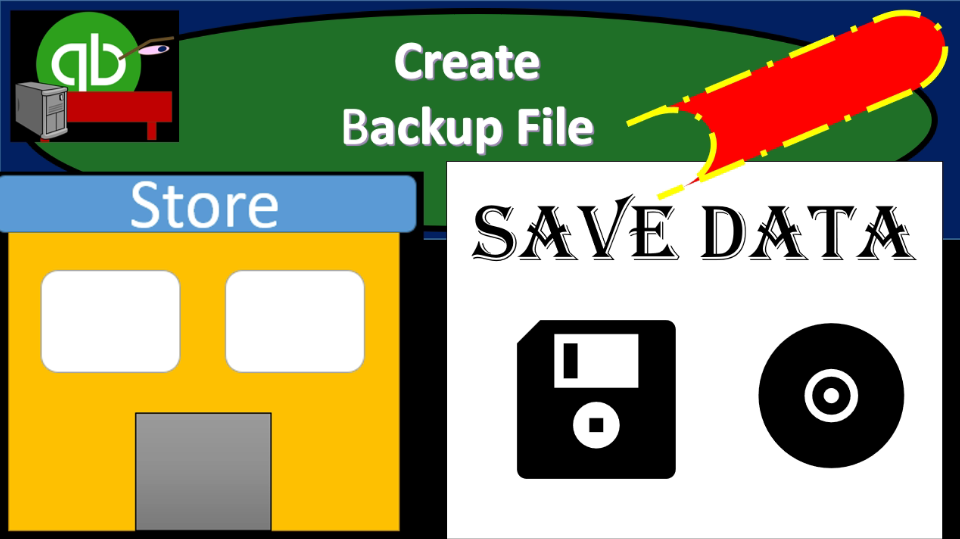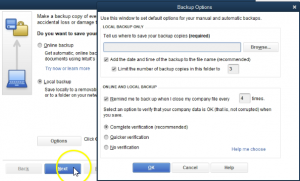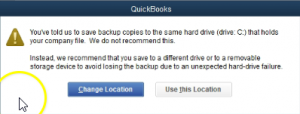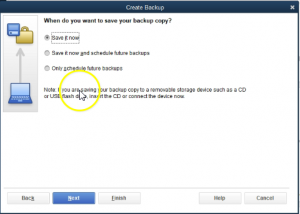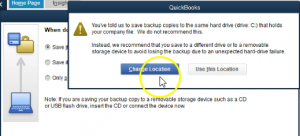In this presentation, we will take a look at QuickBooks data file backup options, and they will create a backup file within QuickBooks Pro 2020, QuickBooks desktop 2020. Here we are in our get great guitars file, we currently have the open windows open, you can open the open windows by selecting the view drop down up top and the open windows lyst.
0:21
When creating a backup file, the first thing you want to think of is where do you want to put that backup file and where you want to put that backup file will also depend on what the reasons for the backups are. So most of the time, of course, when we backup our data file, the reason we want to have the backup file is to have a backup in case there’s a problem with the original file. And therefore we can just go to the backup and we have the support of our data.
0:48
However, there may be other options or other reasons, we might want to use a backup file. For example, we might have a backup file that we want to then have a separate backup file that we can then give to somebody else, such as as our CPA, so that they can look at or our tax preparer. And they can get that information and use it in a separate file and not have access or not be manipulating the current data in our current data file. Or we might be using a backup file to test something. And so we might want to have a backup file and then do something within QuickBooks to see what would happen to it possibly, and then restore the original file
1:24
so that we can then restore to the original settings. And it’s also very useful to have a backup file just for practice. So if you’re trying to practice something, such as if you are a student, then it’s useful to have backup files that will have different locations for static backups. For a something like we have here, a practice problem that we will be going through in the future practice, our static backup files can then provide us the data up to a certain point in time. So it’s very useful for something like students as well.
1:53
But of course, the primary use of the backup file is to support the data in case there’s some kind of crap in our in our normal file and we can’t retrieve the data, we can then go to the backup file. When we consider that type of backup, then, the consideration then is where do we want to put the backup file, where’s it going to be? Now what we want to do is have it somewhere other than our normal hard drive typically. So if we have it on the same hard drive, it may solve a problem if there’s a problem with the actual QuickBooks software or the QuickBooks file.
2:25
However, if there’s a problem to the entire computer, if the computer breaks in some way, and the hard drive has a problem with it, we will lose the data file and the backup file. So if that is our intent, our goal then typically will be to save it somewhere else, you can save it to another hard copy a hard file, for example, you could get external hard drives, and actually swap out the external hard drives, I would get more than one, if that’s going to be your file saving option. So that you can basically save it to the external hard drive, and then possibly alternate the external hard drives from time to time daily if possible. And then you’ll have multiple, basically hard drives of your data. And that’s going to be another way that you can, you can do that you can even take that hard drive home and take it some to other some other location.
3:14
For example, if you work in the office, then you can take the hard drive of the data. And you can take it home periodically. And therefore if there was a fire in the building, then you would have your data in at home on the hard drive. Obviously, the other option you have these days is the online option. And that’s a great tool as well, because you can then save it online. And again, if there’s a problem to your entire office burns down, then the hard drives within it will all burn down with it.
3:44
But you’ll still have the cloud copy. And that should be a good way to go. As we practice here, we’re going to be putting it on the same hard drive that we are on so that we can practice just saving the backup file. And again, that could be very useful for many other reasons that you might want the static hard drive if you’re a student. Or if you just want to practice something if you want to test something out, then there are other many reasons why you might want the hard drive on the same file just to have the backup file. So let’s go through how to set up the backup file.
4:12
To do that, we’re going to go to the File tab up top, we will then go to the backup company. So backup the company and we want to create a local backup file. So we’re going to create local backup. Now we’re going to be using the local backup as opposed to the online backup again, you could use the online option for the backup. And that might be useful because it could say something outside of the office. And that could be useful in case of something like a fire.
4:39
Therefore, we will stick with the local backup, we’re going to now take a look at the options. So if you select the options down below here, our our options, tell us where to save the backup file, we can browse and save the backup file here we have some options down below, including adding the date and time of the backup to the file name.
4:58
This is nice to have you because obviously when you go into the backup file, the question is always when I want to restore it, I will how recent is the backup file, it’ll also make it easier to save multiple backup files to the same folder, because they won’t have the same name because they’ll have a different date and timestamp. So that’s the default setting to have that checked off, it’s usually a good one. And then you can limit the number of backup copies in this folder. So in other words, you’re going to be saving your backup files to the same location.
5:25
Once you do this, for a long period of time, these are fairly large files that can take up a lot of space. So you may not want a whole lot of backup files within their they default, then to three, and then they’re going to basically delete the prior backup file. So you’ll have three backup files at all times, you may want to increase this a little bit, I usually keep it a little bit higher than that. But that’s a nice system to have so that you don’t end up with a you know, a year down the line with you know, 365 backup files, which can take up a lot of room. And then we have the remind me to back up when I close my computer file every four times. So that’s going to be the default.
6:03
Whenever you close QuickBooks, it’s going to say hey, do you want to have a backup system? Do you want to backup the data. And it’s going to remind you every four times to do that in that you can think well is that a reasonable amount of time that I should be backing it up, I would actually backup the system, at least nightly. Or if you don’t use it every day, every time you make a change. I mean, every time you make a change, you might as well make a backup file doesn’t take all that much time. So I typically will do that every time I I opened the QuickBooks unless I’m just looking at it.
6:31
For if I’m actually making any changes to it, I’ll typically back up the QuickBooks file. And then we have the options down before below, select an option to verify that your company data is ok. That it is not corrupted when you save. So you can have the complete complete verification, that’s the default, that’s the recommendation, quicker verification or no verification. So I would typically keep it on the default there. So now I’m going to close this out.
6:58
Now I’m going to close this out. Note that we went there by going to the option selection here, we’ll get in essence the same screen if we go through what we will normally do, which I would normally do going through the process, I select a local backup. And then I simply go to the next item down below. And we get this bit this screen, then I would say Well, once these are all set up the way we want them to be, we’re simply going to go to the browser, which is going to be the location on whatever drive we have to see where we want to put it.
7:26
Now if you want it on an external drive, then an external drive will show up something like this will have whatever port it is in. And then we could save it to an external drive that is connected to the computer, I’m actually going to put ours on our desktop once again in our folder that we have been setting up. Also note that you have this kind of drop down screen, you’ll actually have two screens to put this information in. So if you’re not used to this drop down screen, don’t worry, there’ll be another screen that will look more like a normal kind of saving type of screen. So I’m going to say I want the good, great good.
8:01
And then I want to put it in this folder. Now I’m just going to save it to this folder. Now I actually would like to create a new folder, which I cannot do with this screen. But in the in the future screen, I should be able to so I’m just going to select this folder for now. Then I’m going to say okay, and then I’ll say okay, down below, say okay, and then notice what it saying hits.
8:22
Let’s read this one, actually, you’ve told us to say backup copies to the same hard drive C drive that holds your company file, we don’t recommend this. Instead, we’d recommend that you save to a default drive or a removable storage device to avoid losing the backup due to an unexpected hard drive failure. So what they’re saying is don’t save it to the same drive that your company file is on. Because if the whole drive goes down, you lose both files.
8:50
But for us, we’re going to say okay, we’re going to use this location anyways. And then I’m going to say either save it now, save it now and schedule future backup. So you could have a schedule setting for setting up the future backups, or only schedule future backups. So if you would like to basically schedule have a scheduling option you could do so for me, I don’t think it doesn’t take too long to backup the system. So every time I really make a change, if it’s significant at all, or at least once a day, I’ll save it. So if I get into the practice of backing up at the end of the day, if I use it every day, if that’s what I’m, that’s what I’m doing. Or if I use it periodically, every time I open QuickBooks, I will in essence, make a backup file when I’m done.
9:32
So I’m going to say save it now. So we’re going to say next, then notice we have another browser screen, which again is very similar to the last browser screen we had. But now we have the windows open that we can then navigate through. What I’m going to do is create a new file here. And I’m going to say Actually, I’m going to say new, and then folder. And I’m just going to call it back up backup files, and this is where we’re going to put our backup. I will double click on there. And then that’s where I’m going to put it notice the name down below has guitars and it has the backup and then the date on it.
10:09
Also note the file type is a QBB file a backup file as opposed to the QPW file, which is the right file or the one that we will typically be using. When we when we do stuff in QuickBooks. So we’re going to say Save, and then we’re going to say you’ve told us to save Yes, I want to use this location. And there we have it. So now it’ll generate the backup file for us. Remember that the backup file will actually be another or a separate file. So we’re gonna have two files when we think of the backup file, the major file that we use to write or to change data in and then the backup file.
10:46
So if we open up the folder then that has this in it. Notice this is the get great guitars file that we’re actually running. This is the file that we’re in or the actual right file. And then the backup file we put in the folder here is going to be here and notice if we think about the backup file, the file type is going to be the type of file is a QuickBooks company backup type, as opposed to the actual QuickBooks writing file. It’s a QBB type of file. So note that if you want to then restore this backup file, in other words, whenever we open the QuickBooks then from going on into the future, we’re not obviously going to be opening the backup file will be opening the actual file. If we then needed to restore the backup file at any time, we would then go to the restoration process which would be going to the File tab and then we go to open or restore the company and we would not want to then restore the backup file a similar process that we have gone through it in a previous presentation.

